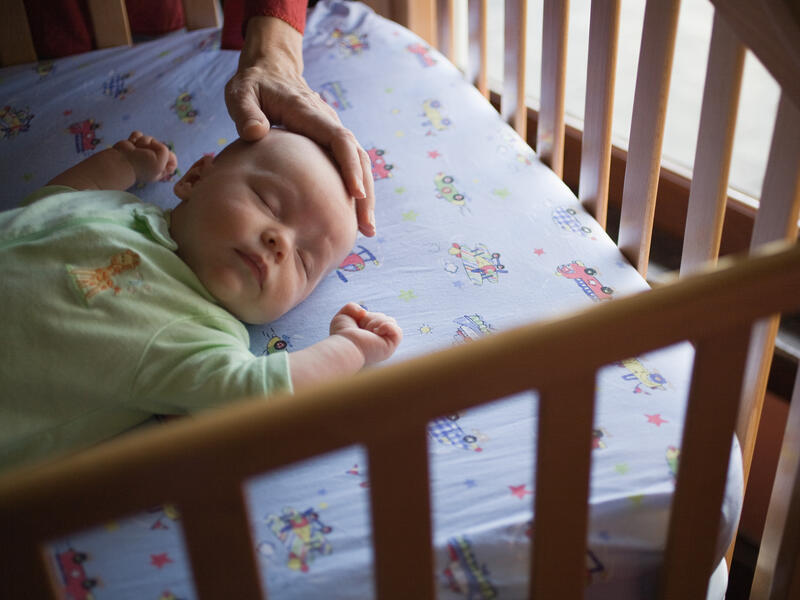Nearly 3,500 U.S. infants die suddenly and unexpectedly each year.
Sudden infant death syndrome is the sudden and unexplained death of a baby younger than 1 year old.
There is no single risk factor that appears likely to cause a SIDS death. Instead, several combined risk factors may contribute to a SIDS death.
Most SIDS-related deaths occur between 2 to 4 months of age, with the incidence increasing during cold weather. SIDS is more likely to occur in boys than girls and in Black and Native American infants. Most SIDS deaths are associated with sleep.
Among the risk factors are:
- Smoking, drinking or drug abuse during pregnancy
- Poor prenatal care during pregnancy
- Premature birth or low birth weight
- Mothers younger than 20
- Secondhand tobacco smoke exposure
- Previous episodes of apparent life-threatening events
- Apnea (pauses in breathing)
But you can help reduce some risks. SIDS becomes less common when parents practice recommendations from the American Academy of Pediatrics.
Let’s learn what you can do to keep your baby safe.
Clear the clutter
Clear out your baby’s sleep area of blankets, pillows, stuffed toys or bumper pads.
Why: Soft and decorative items in a baby’s sleep area increase the risk of suffocation or sudden infant death syndrome. Your baby isn’t strong or coordinated enough to remove soft items from their face.
Not too warm
Use a sleep sack, not a blanket, to keep your baby warm if you are worried about the cold. Dressing baby in one less layer than you have on should keep baby comfortable and not overheated.
Why: Studies show that an overheated baby can fall into a deep sleep from which they are difficult to arouse. Too many clothes or blankets and a higher temperature in the room put a baby at increased risk.
Breastfeeding
Breastfeed as long as you can.
Why: Human milk can lower the risk of SIDS and give protection to your baby. It is recommended that breastmilk be the sole source of nutrition for your baby for about 6 months.
Back to sleep
Until your baby turns 1, your baby should be placed on their back, not their side or stomach. Every nap, every night, every time.
Why: Babies who sleep on their backs are much less likely to die from SIDS than babies who sleep on their stomachs or sides.
Firm, flat surface
A crib, bassinet or portable playard is safe. If your baby falls asleep in a car seat, stroller, swing or infant carrier, move your baby to a firm sleep surface. Never let your baby sleep on a couch or chair.
Why: Infant equipment that is not made for sleeping can put your baby in dangerous positions that make it harder for them to take a full, deep breath.
Share your room, not your bed
Room sharing is recommended, ideally for a year but especially the first six months. Place your baby’s crib, bassinet or pack ‘n’ play close to your bed.
Why: The American Academy of Pediatrics recommends room sharing because it can decrease the risk of SIDS by as much as 50%, and it is much safer than bed sharing.
Keep air moving
A well-ventilated sleeping area is safer for a baby.
Why: According to one study, sleeping with a fan lowers the risk of SIDS by 70%.
More SIDS prevention tips
- Receive early and regular prenatal care.
- Make sure your baby receives all recommended immunizations. Research shows that immunized babies are 50% less likely to be a victim of SIDS.
- Make sure your baby has regular well baby checkups.
- If your baby has gastroesophageal reflux disease (GERD), follow your doctor’s guidelines on feeding and sleep positions.
- Never sleep with your baby or allow other children to sleep with baby.
- Give your baby plenty of interactive tummy playtime.
- When you travel with your baby, be sure to plan a safe place for them to sleep.
- Offer your baby a pacifier at nap time and bedtime, but don’t hang it around baby’s neck or attach it to their clothing when they are sleeping.
- If you take your baby to day care or leave them with a babysitter, provide a copy of this list to them. Make sure they follow all these recommendations.
These simple changes can dramatically lower your baby’s risk for SIDS. Communicate these to any caregivers of your child as well. For more information, see the Safe to Sleep educational website.
Learn more
- Is your baby getting all the sleep needed? Are you?
- How to encourage good sleep habits in children
- Keep kids safe: The ABCs of childhood injury prevention
…
Posted In Children's, Health Information, Parenting, Pregnancy, Sleep Medicine, Specialty Care
